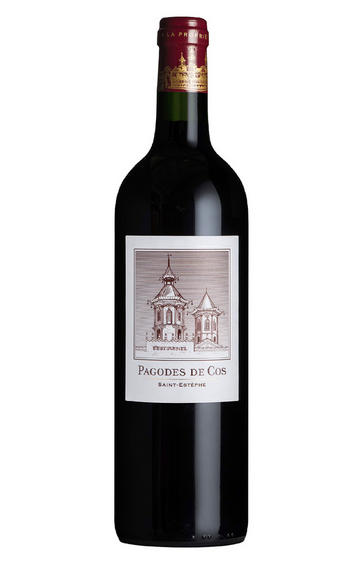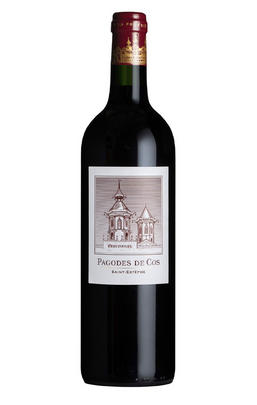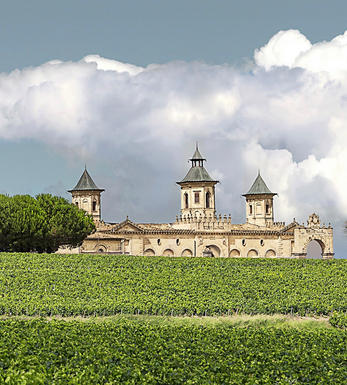
2020 Pagodes de Cos, St Estèphe, Bordeaux

Critics reviews
Drink from 2023 to 2030
Neal Martin, Vinous (May 2021)
Drink from 2025 to 2035
Antonio Galloni, Vinous (June 2021)
Drink 2024 - 2038
Jane Anson, Decanter.com (May 2021)
The 2020 Les Pagodes de Cos is composed of 58% Cabernet Sauvignon, 34% Merlot, 4% Cabernet Franc and 4% Petit Verdot. The harvest took place September 10–24 with a yield of 39 hectoliters per hectare. The alcohol weighs in at 13.28% with a pH of 3.85 and an IPT (total phenolic index) of 68. It is being aged in French oak barrels, 30% new.
Medium to deep garnet-purple colored, it sashays out of the glass with pretty, open-knit scents of stewed black plums, boysenberries and warm cassis, plus savory hints of charcuterie, woodsmoke, black truffles and bouquet garni. Medium-bodied, the palate is packed with crunchy black fruit flavors and dried herbs accents, supported by bags of freshness and well-managed, grainy tannins, finishing with great length and a lively skip in its step.
Drink 2024 - 2039
Lisa Perrotti-Brown MW, Wine Advocate (May 2021)
Drink 2027 - 2040
James Lawther MW, JancisRobinson.com (April 2021)
James Suckling, jamessuckling.com (April 2021)
Jeb Dunnuck, jebdunnuck.com (May 2021)
Drink 2025 - 2035
Michael Schuster, The World of Fine Wine (May 2021)
About this WINE

Cos d'Estournel
Château Cos d`Estournel is named after its 19th century owner, Louis-Gaspard d'Estournel, and it was he who built the bizarre oriental edifice that is a landmark for any tourist in the Médoc. Today Cos d'Estournel is without doubt the leading estate in St-Estéphe. It is located in the south of the appellation on the border with Pauillac and its vineyards are superbly sited on a south-facing gravel ridge with a high clay content, just north of Lafite.
Cos d'Estournel is typically a blend of 60% Cabernet Sauvignon, 38% Merlot and 2% Cabernet Franc - do not be fooled by the relatively high Merlot content, as these are full-bodied, dark, brooding tannic wines when young which develop a complexity and intensity that can rival many top growths from Pauillac.
In 1998 the Prats family sold Cos d'Estournel to The Tailan Group. Cos d'Estournel is classified as a 2ème Cru Classé.

Saint-Estèphe
Saint-Estèphe is the northernmost of the most important communes of the Médoc and borders Pauillac on its southernmost border, with only a gully and stream separates it from Ch. Lafite. To the north lies the Bas-Médoc.
Saint-Estèphe is defined by the depth of its gravel, which is ubiquitous but of varying depths and occasionally very shallow, when clay predominates. This keeps the soil cooler and wetter than its counterparts so that the wines can appear fresh in lighter vintages, but superbly successful in hot, dry years.
The best châteaux in the south of the commune have the deepest soil and the thickest gravel. Cos d'Estournel has an exceptional terroir with its vineyards being located on a south-facing ridge of gravel with excellent drainage.
Saint-Estèphe is the least gravelly of main Médoc communes and in the north of the commune the vineyards are heavier and more clay-based leading to a rustic style of wine being produced.
The wines can appear austere in youth with a discernable ferric note at some châteaux, but the best typically display good depth of colour, pronounced acidity an tannins in youth and are exceptionally long-lived. At their best, they are the equal of almost any Bordeaux. The well-regarded St Estèphe co-operative controls the production of about half the appellation.
Recommended Châteaux
Cos (Ch. Cos d'Estournel), Ch. Montrose, Ch. Calon-Ségur, Ch. Lafon-Rochet, Ch. Les Ormes de Pez, Ch. Beau-Site, Ch. Cos Labory, Ch. Phélan-Ségur

Cabernet Sauvignon Blend
Cabernet Sauvignon lends itself particularly well in blends with Merlot. This is actually the archetypal Bordeaux blend, though in different proportions in the sub-regions and sometimes topped up with Cabernet Franc, Malbec, and Petit Verdot.
In the Médoc and Graves the percentage of Cabernet Sauvignon in the blend can range from 95% (Mouton-Rothschild) to as low as 40%. It is particularly suited to the dry, warm, free- draining, gravel-rich soils and is responsible for the redolent cassis characteristics as well as the depth of colour, tannic structure and pronounced acidity of Médoc wines. However 100% Cabernet Sauvignon wines can be slightly hollow-tasting in the middle palate and Merlot with its generous, fleshy fruit flavours acts as a perfect foil by filling in this cavity.
In St-Emilion and Pomerol, the blends are Merlot dominated as Cabernet Sauvignon can struggle to ripen there - when it is included, it adds structure and body to the wine. Sassicaia is the most famous Bordeaux blend in Italy and has spawned many imitations, whereby the blend is now firmly established in the New World and particularly in California and Australia.


Buying options
Add to wishlist
Description
Cabernet Sauvignon 58%, Merlot 34%, Cabernet Franc 4%, Petit Verdot 4%
This, the second wine of Cos d’Estournel, is given the same lavish attention as the grand vin. Some of the fruit now comes from vineyards from the old Ch. Pomys, once part of the old estate, now reunited. The bouquet has a fresh and lifted aroma, cultured and with hallmark St Estèphe spice. The palate is layered; there is a sense of translucency. The commune’s grainy tannins work brilliantly in adding tension and freshness. The wine is not overtly juicy or red fruit-accented; instead, there is a satisfyingly cool mineral edge.
Drink 2025-2038
wine at a glance
Delivery and quality guarantee